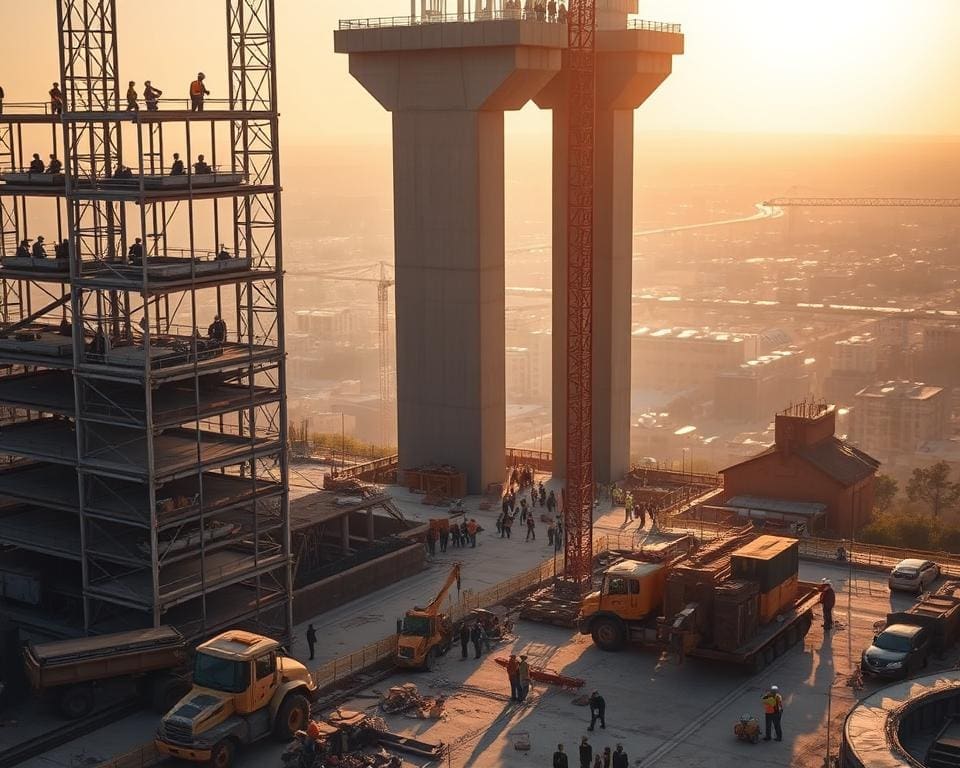Infrastructure projects are vital to the growth and sustainability of modern societies. However, they are not without their challenges. From funding limitations to regulatory hurdles, the obstacles in infrastructure can impede progress and innovation. Understanding these infrastructure work challenges is essential for orchestrating successful outcomes. As we delve into the intricacies of these infrastructure project difficulties, it becomes evident that addressing these issues is crucial for paving the way for resilient and efficient infrastructure systems.
Understanding the Scope of Infrastructure Work
Infrastructure work encompasses a broad range of components essential for the functioning of society. Recognition of the infrastructure definition reveals its critical role in connecting people and facilitating economic development. Understanding the importance of infrastructure sheds light on how these systems bolster quality of life and enhance productivity across various sectors.
The Definition and Importance of Infrastructure
The infrastructure definition typically includes systems related to transport, utilities, and facilities that support societal activities. Roads, bridges, water supply systems, and energy networks are vital for daily functioning. Recognising the importance of infrastructure is crucial; these elements enable economic growth, improve public health, and foster social cohesion. Investment in robust infrastructure demonstrates a commitment to future developments, contributing to a more connected and prosperous nation.
Types of Infrastructure Projects
Types of infrastructure projects vary significantly, encompassing numerous domains. Key examples include:
- Transport projects such as highways, rail networks, and airports
- Utility projects that supply water, electricity, and natural gas
- Communication infrastructure, including broadband networks and telephone services
These various projects work in synergy, creating a foundation upon which communities thrive. Awareness of these types of infrastructure projects highlights their interconnected nature and their overall impact on society.
What are the biggest challenges in infrastructure work?
The landscape of infrastructure work is littered with substantial challenges that hinder progress. Among these, funding and budget constraints top the list, presenting formidable barriers to project completion. Regulatory issues further complicate the landscape, often constructing an intricate web of compliance necessary for any development. Finally, the rapid pace of technological innovations brings both advancements and obstacles, shaping the future of infrastructure in significant ways.
Funding and Budget Constraints
Funding challenges in infrastructure have become an ever-pressing issue. The National Audit Office reveals that project delays frequently arise due to insufficient financial backing. Many schemes, despite their importance, remain stalled because budgets are inadequate to meet escalating costs. Stakeholders must navigate funding sources creatively, often needing to combine public and private investment to achieve their goals.
Regulatory and Compliance Issues
Regulatory issues play a pivotal role in the infrastructure sector. Navigating extensive legal frameworks can dramatically extend project timelines. Compliance can become a bottleneck, often delaying the awarding of contracts or the initiation of work. Authorities need to streamline processes and clarify regulations to avoid hindering essential projects due to bureaucratic complexities.
Technological Innovations and Their Impact
The technological impact on infrastructure is profound and multi-faceted. Innovations such as smart technologies are revolutionising how projects are designed and executed. While these advancements promise enhanced efficiency and sustainability, they also introduce new challenges. Integrating cutting-edge technologies into existing systems requires significant investment and planning, creating hurdles that stakeholders must address to harness the full benefits of modern infrastructure solutions.
The Role of Public-Private Partnerships (PPPs)
Public-private partnerships have emerged as a vital approach to tackling the substantial challenges of infrastructure development. These collaborations leverage the strengths of both sectors, providing innovative solutions that enhance project outcomes. A deep understanding of the benefits of PPPs can illustrate why they gain traction in today’s infrastructure landscape.
Benefits of PPPs in Infrastructure Projects
The benefits of PPPs in infrastructure projects are diverse and impactful. These partnerships allow for:
- Risk-sharing, which mitigates the burden on public entities by distributing potential risks between partners.
- Access to private sector efficiency, ensuring projects are delivered on time and within budget, benefiting communities significantly.
- Innovative financing solutions, enabling projects that may not otherwise receive adequate funding to commence.
A notable example includes the Thames Tideway Tunnel in London, which showcases how these partnerships can transform regional infrastructure while addressing environmental concerns. Projects like this not only enhance resilience but also promote sustainable practices.
Challenges Associated with PPPs
- Complex contractual agreements, which can create uncertainty and confusion for all parties involved.
- Potential conflicts of interest, where private profitability may conflict with public welfare, undermining stakeholder trust.
- Dependence on long-term financial commitments, which can complicate project viability in changing economic climates.
Industry experts highlight that addressing these challenges is essential for the sustained success of PPPs in infrastructure. Insights from the National Infrastructure Commission further emphasise the need for clear policies and frameworks that support equitable outcomes for all stakeholders.
Environmental Concerns and Sustainability
The pressing environmental concerns surrounding infrastructure projects demand urgent attention, particularly with the rising climate change challenges. These challenges pose significant threats to the resilience and longevity of existing infrastructure. A comprehensive understanding of the environmental impact of infrastructure can help in formulating effective responses to these pressing issues.
Impact of Climate Change on Infrastructure
Extreme weather events, such as flooding and heatwaves, disrupt the integrity of infrastructure systems. Such phenomena have emphasised the critical need for adaptation in infrastructure design. Statistics from the UK Climate Change Act reveal alarming trends, indicating an increase in the frequency and intensity of extreme weather conditions. As a result, sustainable infrastructure solutions must prioritise durability and resilience in light of emerging climate realities.
Innovative Solutions for Sustainable Development
Various innovative strategies are being employed to enhance sustainability in infrastructure projects. Industries are increasingly incorporating green building practices that utilise renewable materials and energy-efficient technologies. Initiatives led by companies like ARUP demonstrate how engineers and architects can collaborate to create eco-friendly designs. These projects not only address the environmental impact of infrastructure but also set new standards for sustainable development.
Labour and Skills Shortages in the Sector
The infrastructure sector in the United Kingdom is currently grappling with significant labour shortages in construction, particularly as the workforce ages and the demand for skilled workers increases. According to data from the Construction Industry Training Board (CITB), this trend is creating substantial gaps in crucial fields such as engineering and project management. The result is a pressing need for strategies that will engage younger generations and attract new talent into the industry.
Amid these workforce challenges in engineering, the necessity for effective reskilling programmes has never been more urgent. Educational institutions and industry stakeholders must collaborate to bridge the skills gaps in infrastructure, ensuring that new entrants are adequately prepared for the evolving demands of the sector. By fostering partnerships that provide hands-on training and apprenticeships, the infrastructure industry can help cultivate a robust talent pipeline.
Moreover, showcasing the diverse and rewarding career pathways available in infrastructure is essential in motivating younger professionals. As the sector embarks on ambitious projects that require innovative solutions, tapping into the potential of a fresh and dynamic workforce will be key to overcoming the challenges posed by labour shortages and ensuring a sustainable future for the UK’s infrastructure landscape.









